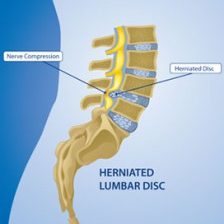Slipped Disc Treatment in Pune
A Cause of Regional Body Pain
The spine consists of bones called vertebral bodies, which are stacked on top of each other and separated by shock absorbers known as discs. The disc consists of a soft gel-like central portion known as the nucleus pulposus which is surrounded by firm annulus fibrosis. When a tear or crack in the annulus fibrosis occurs, a portion of the soft gel part of the disc may extrude through this tear and cause pressure upon a nerve or the spinal cord. This is commonly known as a herniated disc. Other terms used for this condition include:
• Bulging disc
• Ruptured disc
• Slipped disc
• Extruded disc
• Free Fragment

When a herniated disc presses on a nerve, it may cause symptoms to occur in the part of the body that nerve supplies. For example, if the disc pushes on a nerve traveling to the arm, it may cause pain to appear to be coming from that portion of the arm. This condition is known as radiculopathy. When it affects the legs it is known as sciatica.
A herniated disc may cause sensations of tingling or numbness and weakness. A large herniated disc in the neck may cause compression of the spinal cord and spinal cord damage. A large herniated disc in the lumbar region may cause difficulty with bowel or bladder control. In this case, an urgent operation may be needed to prevent permanent nerve damage.
Herniated discs can occur as a result of trauma to the spine or they may occur with no known cause. Sometimes a patient will recall a specific injury or twisting motion preceding the pain but other times the patient may simply wake up with the pain already there.
The first step in diagnosing a herniated disc is obtaining a complete history from the patient, followed by a detailed physical examination. If the physician is suspicious that a herniated disc may be present, the next step is to confirm this with diagnostic studies. An MRI scan is a very sensitive study which will show herniated discs. If this does not give sufficient detail or if there are remaining questions, a myelogram followed by a CT scan of the spine may provide more information. These imaging studies are excellent at showing the anatomy of the spine but they do not give information about the function of the nerves. If there is a question as to how the nerves are functioning, an EMG/nerve conduction study may help.
Good body mechanics are one’s best prevention for herniated discs. Excessive bending, twisting, and lifting put a strain on the discs in the low back and neck, increasing risks of their herniation. The human body is certainly designed to undergo bending and twisting and lifting, however, we must realize our limitations and try to use good body mechanics whenever possible. For example, when picking a box off of the ground, it is best to bend at the knees rather than at the hips. Bending at the hips places the lumbar spine in significant strain. Likewise, lifting extremely heavy objects causes the bones in the spine to compress against each other. This squeezes the discs which are situated between the bones, placing great pressure on the soft nucleus pulposus gel. If there are any cracks in the annulus fibrosis surrounding the gel, the gel may squeeze through the cracks (similar to toothpaste being squeezed out of a tube) and result in a herniated disc causing pressure on the nerves.
Exercising, keeping one’s bodyweight close to the ideal level and staying in generally good shape helps to decrease the likelihood of herniated discs.
Nonsurgical Options:
Nonsurgical management has a significant role in the treatment of herniated discs. Fifty percent of patients will obtain relief of leg or arm symptoms with these conservative approaches, and return to work and activities in four to six weeks. This approach may require modifications in an activity such as avoiding strenuous activity, bending, twisting or lifting.
Physical Medicine/Physical Therapy Techniques.
• Non-steroidal anti-inflammatory medications
• Spinal epidural injections.
• Oral pain medications.
• A short course of oral steroids.
Surgical Options:
Surgical treatment may have a high success rate (approximately 90%) in treating leg pain due to herniated discs. There are several surgical approaches that may be taken.
• Traditional microdiscectomy.
• Minimally invasive discectomy.
• Endoscopic discectomy.
• Anterior cervical discectomy.
The prognosis of a herniated disc in a lumbar or cervical spine is generally very good. The majority of patients will respond well to conservative care. In those who require surgery, the results are usually very positive with good resolution of extremity symptoms. Much of the prognosis depends on how much nerve damage exists before the surgery. The goal of surgery is to decrease pressure on the nerve. If there has already been significant damage to the nerve, the nerve can take up to 1 ½ year to heal. In patients who have significant pain to the extremities, when the pain is relieved by either surgical or nonsurgical measures, the patients sometimes experience some degree of numbness remaining.